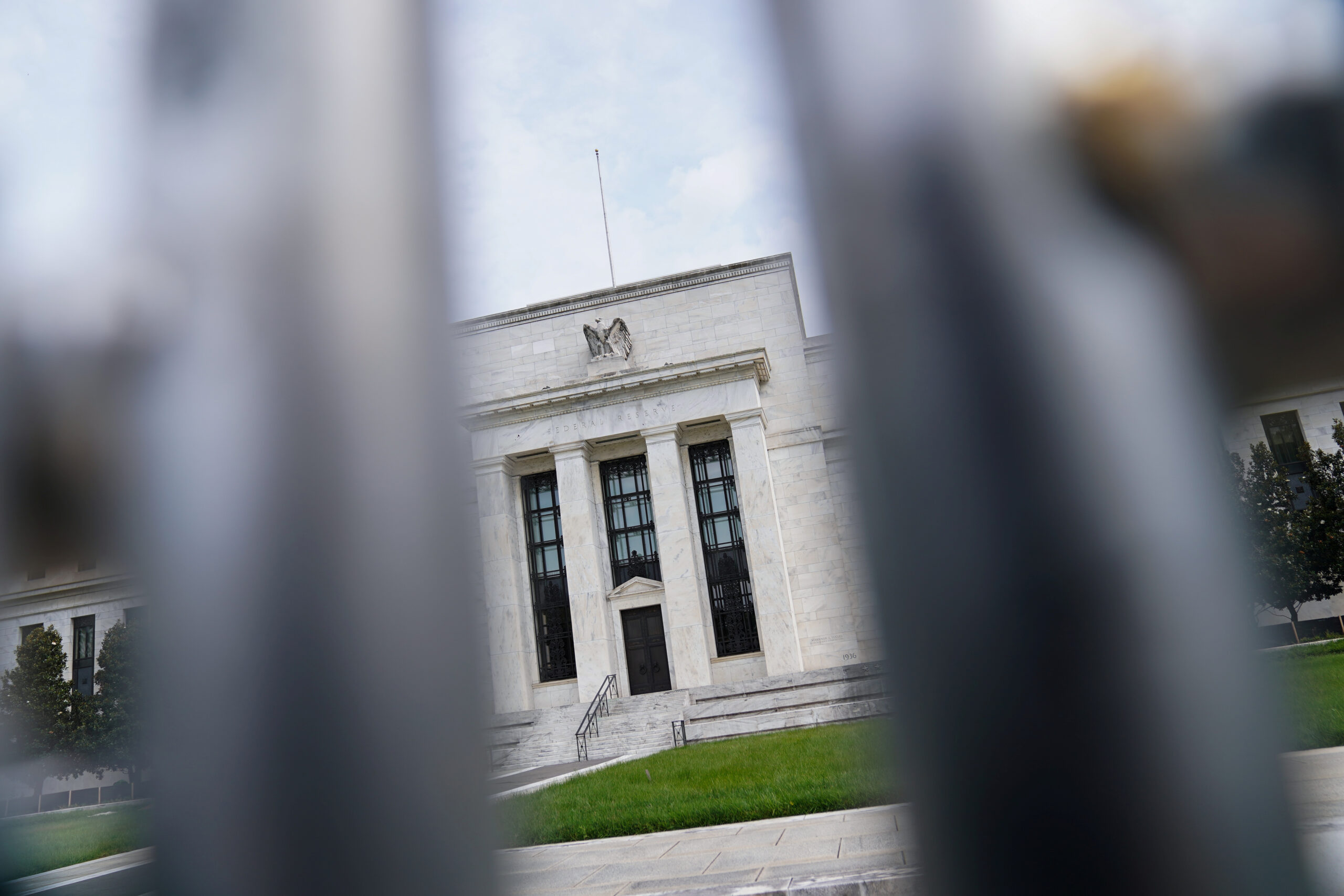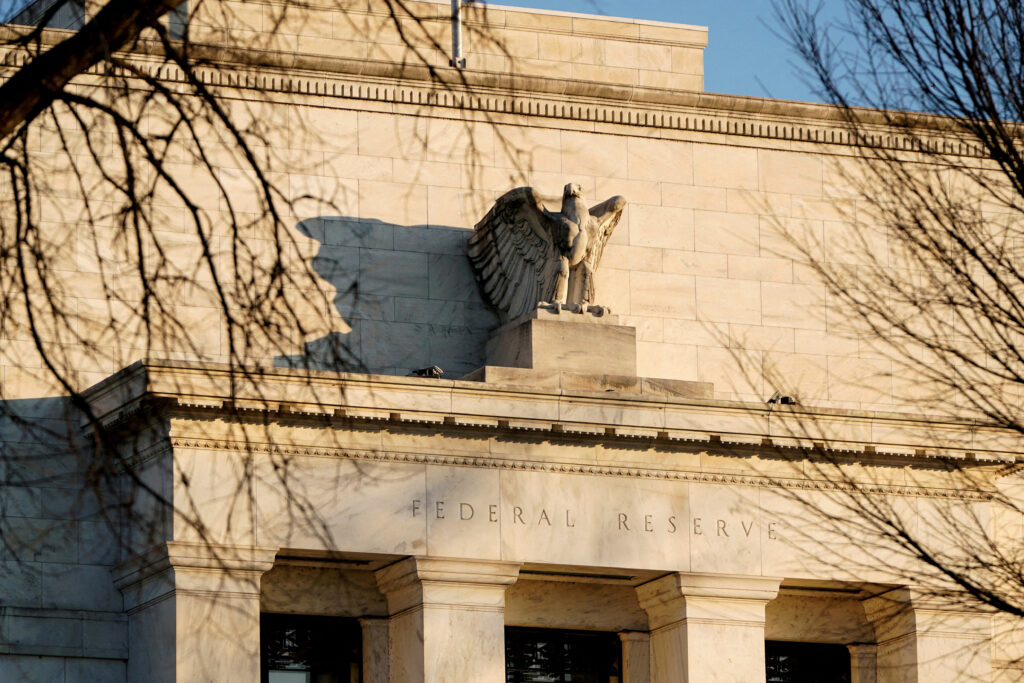The Federal Reserve is nearly as likely to deliver an outsized interest-rate cut next week as a more-usual-sized reduction, trading in rate-futures contracts suggested on Friday, as financial markets priced in a bigger chance that the Fed will move more aggressively.
A quarter-point reduction at the Fed’s September 17-18 meeting is still seen as the slightly more likely outcome, but only marginally so.
Futures tied to the Fed’s policy rate now reflect about a 47% chance that the Fed will cut its policy rate, currently in the 5.25%-5.50% range, by a half of a percentage point. That’s up from about 28% on Thursday.
The market move reflects increasing bets by traders that the Fed may try to head off deterioration in the labor market, rather than take a slower see-what-happens-next approach with a smaller opening reduction.
“Our view is that the Fed is behind the curve – that it should have been easing from June even, or potentially May – and that now it needs to catch up and may have to front-load some of the rate cuts,” Parthenon economist Gregory Daco said.
Last month, Fed Chair Jerome Powell said he would not want to see any further cooling in the labor market, and that “the time has come” to cut rates.
Since then, other Fed policymakers have signaled their sympathy with that view, including San Francisco Fed President Mary Daly who said a weakening job market would be unwelcome. Fed Governor Chris Waller said he would support front-loading rate cuts should conditions merit.
Typically Powell spends the Thursday and Friday before a policy-setting meeting in half-hour one-on-ones with each of his fellow policymakers to discuss the options on the table and the economic conditions that may warrant one over another.
CHANGING SENTIMENT
The change in market sentiment amplifies a discussion that began in earnest at the Fed’s July 30-31 meeting, when “several” policymakers said there was already a “plausible case” to cut rates, according to minutes of the session – a fact that may leave some officials now advocating for a bigger increase in September if they think the Fed should have cut already.
Within days of that meeting, the case grew even stronger when the employment report for July showed the jobless rate rising to 4.3% and employers adding a fewer-than-expected 114,000 new jobs – a slow pace by recent standards that was subsequently revised down to just 89,000. Revisions to benchmark data also showed job creation for the 12 months ending in March had been slower to the tune of 818,000 positions.
The new data fueled the sentiment that the Fed was slipping behind the curve in protecting the job market just as it was slow to begin hiking rates when inflation took off in 2021.
Data for August showed the unemployment rate easing back to 4.2% but job growth slowing to just 116,000 a month on average since June, well below the rate officials see as necessary to prevent the jobless rate from rising.
Powell in comments at the Fed’s annual research symposium in Jackson Hole last month made clear that rates would fall at the Fed’s September meeting. He was noncommittal, though, on how far or how fast the decline might be, or whether officials would open the door with a conventional quarter-point reduction or something larger.
THE CASE FOR BIG OR SMALL
Outside of clear economic threats, easing cycles have tended to begin with quarter-point reductions as central bankers try to reset financial conditions to account for easing inflationary pressures – and several Fed officials ahead of this meeting used words like “gradual” and “methodical” to describe the likely pace.
Others are concerned the labor market is weaker than headline data suggest. Fed Governor Adriana Kugler in particular voiced concern that alternate measures of unemployment beyond the headline rate suggest labor market conditions may be eroding faster than thought.
Alongside the interest rate decision on Sept. 18, the Fed will issue new economic projections from policymakers that will indicate how far they anticipate reducing rates by the end of the year. Investors currently expect 1.25 percentage points of cuts by then, though markets have jockeyed back and forth between bets for smaller and larger cuts over a volatile month of trading.
The way data has evolved does suggest a quicker pace of cuts than suggested not only in June, when Fed policymakers penciled in just one 25 basis point rate cut this year, but also than in March, when the median projection was for three quarter-point rate cuts by the end of the year.
In March, policymakers also saw an unemployment rate of 4% at year-end and a closely watched inflation measure at 2.6%.
That core inflation measure – the Personal Consumption Expenditures price index excluding food and energy costs – hit that year-end projection in July, and the unemployment rate is now higher than they expected it to be at the end of 2024.
“Yes it is an uphill climb, but I think the Federal Reserve will cut its policy rate by 50 basis points at its upcoming meeting,” wrote Renaissance Macro Head of Economic Research Neil Dutta. “The case for doing more upfront is strong.”
(Source: ReutersReuters)
Mark Glenn is a financial journalist and breaking news reporter for ABBO News. Mark is known for his ability to deliver real-time news updates on market developments, mergers and acquisitions, corporate earnings reports, and regulatory changes, helping investors stay informed and make sound financial decisions. Read Full Bio










